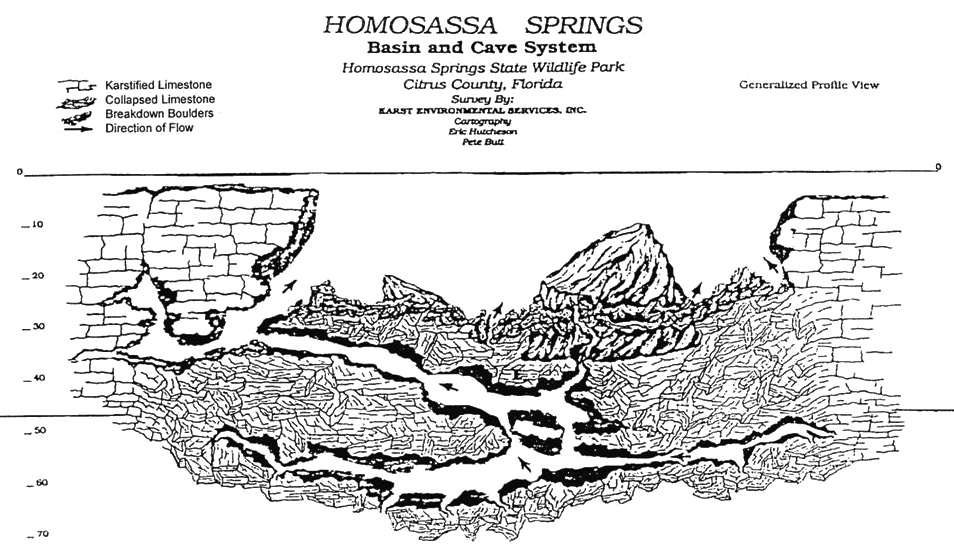Homosassa Springs USA
Portions of the following information were taken from Florida Geological Survey Bulletin 66. The springs are located within the Homosassa Springs Wildlife State Park and form the headwaters of the Homosassa River. Coming from the north on US 19/98 into Homosassa Springs, turn west (right) on CR 490A and travel 0.5 mile. Turn south (left) on access road to Homosassa Springs Wildlife State Park and travel 0.3 mile to park entrance. The spring pool, into which all three vents issue, is just below the underwater viewing platform in the manatee rehabilitation area. Description – Homosassa Springs Group forms the head of the Homosassa River, which flows west approximately 6 miles to the Gulf of Mexico. Downstream from the head springs about a mile, the spring-fed Halls River flows in from the north. The entire river system is tidally influenced. HOMOSASSA SPRINGS NOS. 1, 2, and 3 – All three vents issue into the same spring pool. The pool measures 189 ft north to south and 285 ft east to west. The depth for each of the vents is 67, 65, and 62 ft for spring nos. 1, 2, and 3, respectively. The springs issue from a conical depression with limestone exposed along the sides and bottom of the spring pool. The pool is teeming with salt water and freshwater fishes. Water is clear and light blue. There is a large boil in center of pool. Surrounding land is Gulf Coastal Lowlands with thick hardwood-palm forest cover. Approximately 1,000 ft downstream, a fence spans across the river to keep boats out of the spring pool. There also is a barrier immediately outside the spring area which keeps the captive manatees in the spring pool. Manatees frequent the spring pool and river year round, but are especially common in winter. The springs are tidally influenced year round, especially in winter. Utilization – The main spring pool and adjacent lands are within Homosassa Springs Wildlife State Park. The area is developed into an interpretive center for manatee and Florida wildlife education. There is a floating observation deck in the spring pool with a submerged aquatic observation room. Injured and rehabilitating manatees are captive in the spring pool for year round observation. Swimming is not allowed.
- Region: Florida
- Coordinates: 28.798963, -82.588322
- Depth: 67 ft
- Remarks:
- Type: OW
Directions to the Springs
- If you’re approaching from the north on US 19/98 into Homosassa Springs, take a right turn onto CR 490A.
- Travel approximately 0.5 mile on CR 490A and then make a left turn onto the access road leading to Homosassa Springs Wildlife State Park.
- Continue for about 0.3 mile, and you’ll arrive at the park entrance.
The Springs and Their Surroundings
- The spring pool, where all three vents converge, is located just below the underwater viewing platform situated in the manatee rehabilitation area.
- The Homosassa River, fed by these springs, flows westward for approximately 6 miles before emptying into the Gulf of Mexico.
- About a mile downstream from the head springs, the spring-fed Halls River joins in from the north.
- It’s worth noting that the entire river system experiences tidal influence.
Homosassa Springs: A Closer Look
- The springs, known as Homosassa Springs Nos. 1, 2, and 3, share the same spring pool.
- This expansive pool spans 189 feet north to south and 285 feet east to west.
- Each of the springs has its unique depth: 67 feet for spring No. 1, 65 feet for spring No. 2, and 62 feet for spring No. 3.
- The springs emerge from a conical depression adorned with limestone formations along the sides and bottom of the pool.
- The crystal-clear waters teem with both saltwater and freshwater fish, creating a vibrant aquatic ecosystem.
- A prominent boil graces the center of the pool, adding to its natural allure.
- Surrounding the springs, you’ll find Gulf Coastal Lowlands adorned with lush hardwood-palm forests.
Manatees and Tidal Influence
- Roughly 1,000 feet downstream, a protective fence spans across the river, safeguarding the spring pool from boat traffic.
- Another barrier encircles the spring area, ensuring captive manatees remain within the pool.
- Manatees are a common sight in the spring pool and river, especially during winter.
- The springs remain tidally influenced year-round, with winter showcasing the most significant tidal impact.
Utilization and Conservation
- Homosassa Springs Wildlife State Park encompasses the main spring pool and adjacent lands.
- The area serves as an interpretive center, offering educational insights into manatees and Florida wildlife.
- A floating observation deck, complete with a submerged aquatic observation room, provides visitors with unparalleled views.
- Injured and rehabilitating manatees are cared for within the spring pool, allowing for year-round observation.
- Swimming in the spring pool is not permitted, ensuring the preservation of this unique natural habitat.

FAQ
The depths of Homosassa Springs vary, with spring No. 1 reaching 67 feet, spring No. 2 at 65 feet, and spring No. 3 at 62 feet.
The water in Homosassa Springs typically maintains a cool and pleasant temperature, ranging between 50°F to 55°F (10°C to 13°C).
No, swimming and diving are not permitted in Homosassa Springs. Conservation efforts prioritize the protection of the unique aquatic ecosystem and the safety of visitors.
